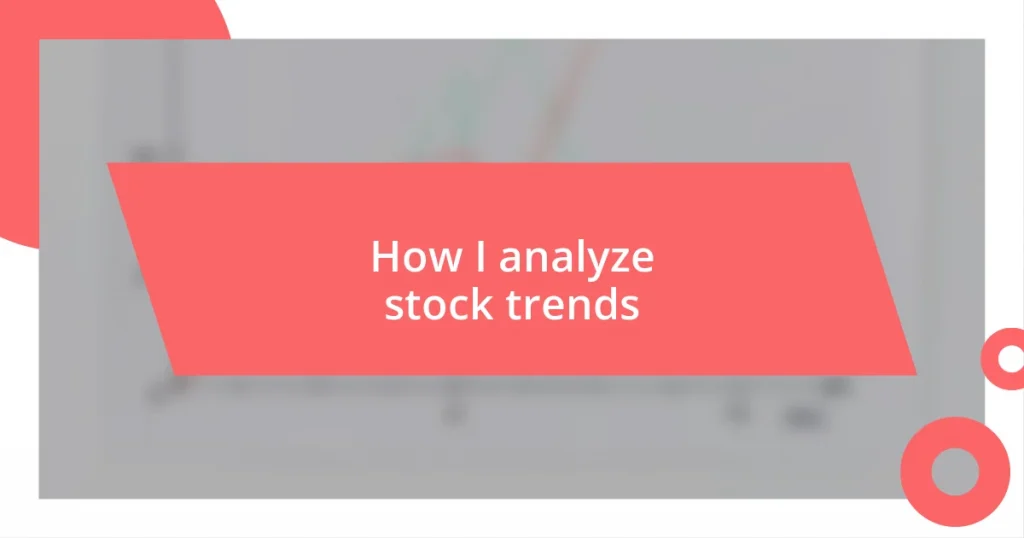Key takeaways:
- Understanding the distinctions between common and preferred stocks is crucial for informed investment decisions, impacting both voting rights and returns.
- Utilizing reliable historical data and key technical indicators, such as Moving Averages and RSI, enhances trend analysis and trading strategies.
- Monitoring market news and economic indicators can significantly influence investment choices, highlighting the importance of staying informed and agile in response to market dynamics.
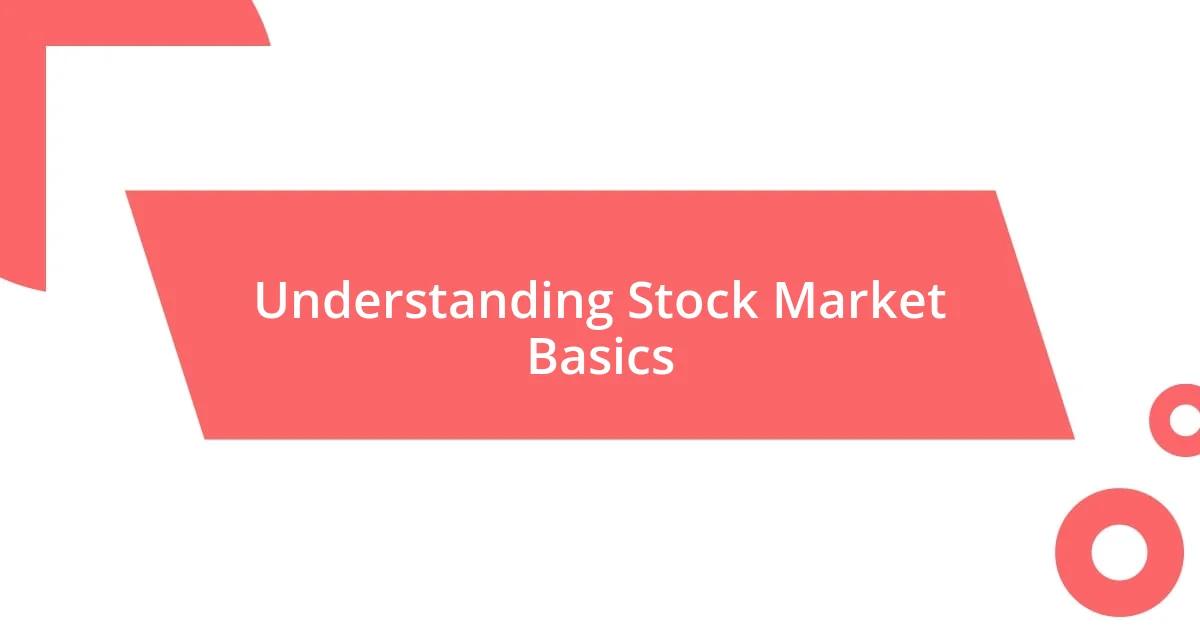
Understanding Stock Market Basics
Understanding the stock market is much like learning a new language; at first, it can feel overwhelming, but with practice, it becomes familiar. I remember my initial days trying to decipher stock charts, the sense of confusion often left me feeling lost. Have you ever felt that way? With time, I realized that grasping the basics—like what stocks are, how they are traded, and the concept of market capitalization—made the process much clearer.
One of the most eye-opening moments for me was learning about the different types of stocks, like common versus preferred stocks. It turned out that common stocks offer voting rights and potential dividends, while preferred stocks provide more stable returns without the drama of voting—something I wish I’d understood earlier! Understanding these differences can significantly influence your investment choices and strategy.
I’ve come to appreciate that the stock market is not just a realm for the experts; anyone can get involved. Have you considered how emotions, like fear and greed, can massively impact market trends? It’s fascinating to witness how these emotions can sway investors’ decisions, driving prices up or down, often leading to volatility that can create both risk and opportunity in trading.

Gathering Historical Data
When it comes to gathering historical data, I can’t stress enough how crucial it is to have reliable sources at your fingertips. Early in my trading journey, I turned to free online platforms, but I quickly realized that not all data is created equal. The accuracy, completeness, and timeliness of information can make a huge difference in how you analyze trends. Have you ever been caught off-guard by outdated data? I know I have, and it’s never a pleasant surprise.
Utilizing databases that aggregate historical stock prices is a game-changer. For example, I often use sources like Yahoo Finance and Google Finance, which provide detailed price charts and performance data spanning years. Comparing this data over different time frames can reveal patterns that might not be apparent at first glance. I remember discovering a recurring seasonal trend in one stock that helped me position my trades much more effectively — it was like finding a hidden treasure in the data!
Lastly, exporting this information for personal analysis can be incredibly insightful. I often download CSV files for deeper dives into the numbers, allowing me to visualize trends and spot anomalies. There was a moment when I noticed a sudden drop in a stock’s price that deviated from its historical average. Investigating further, I uncovered a temporary market anomaly caused by external news — a lesson learned that helped refine my analytical skills dramatically.
| Source | Data Type |
|---|---|
| Yahoo Finance | Historical stock prices, dividends, events |
| Google Finance | Price charts, performance comparisons |
| Financial Modeling Prep | Key metrics, historical financial statements |
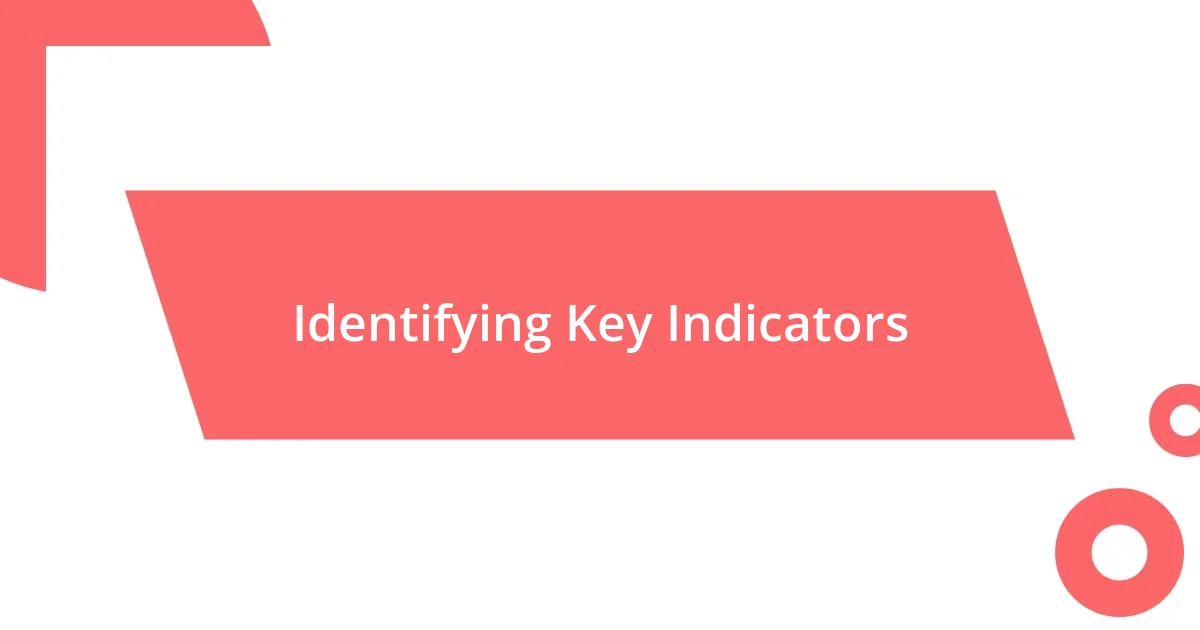
Identifying Key Indicators
Identifying key indicators is essential for making informed investment decisions. I still remember the first time I came across technical indicators; it was like flipping a switch in my mind. My eyes were opened to tools like moving averages and Relative Strength Index (RSI), which provided me clarity in interpreting price movements. These indicators helped to unveil trends I previously overlooked, guiding me to make smarter trades.
Here are some critical indicators I always keep an eye on:
- Moving Averages (MA): They smooth out price data to identify the direction of the trend and help determine buy or sell signals.
- Relative Strength Index (RSI): This momentum oscillator measures the speed and change of price movements, indicating if a stock is overbought or oversold.
- Volume: Monitoring trading volume can signal the strength behind a price movement; increasing volume often indicates a stronger trend.
- Bollinger Bands: They highlight volatility and potential price levels, giving insight into market conditions.
- Stochastic Oscillator: This compares a stock’s closing price to its price range over a specific period, helping to identify potential reversal points.
As I integrated these indicators into my analysis, the confidence I felt in my trades grew immensely. It wasn’t just numbers; they were like whispers from the market, guiding me through my decisions. I recall feeling particularly empowered when I correctly predicted a bullish trend using the RSI, which marked a turning point in my trading approach. That moment showed me the value of embracing these technical indicators instead of merely relying on gut feelings.
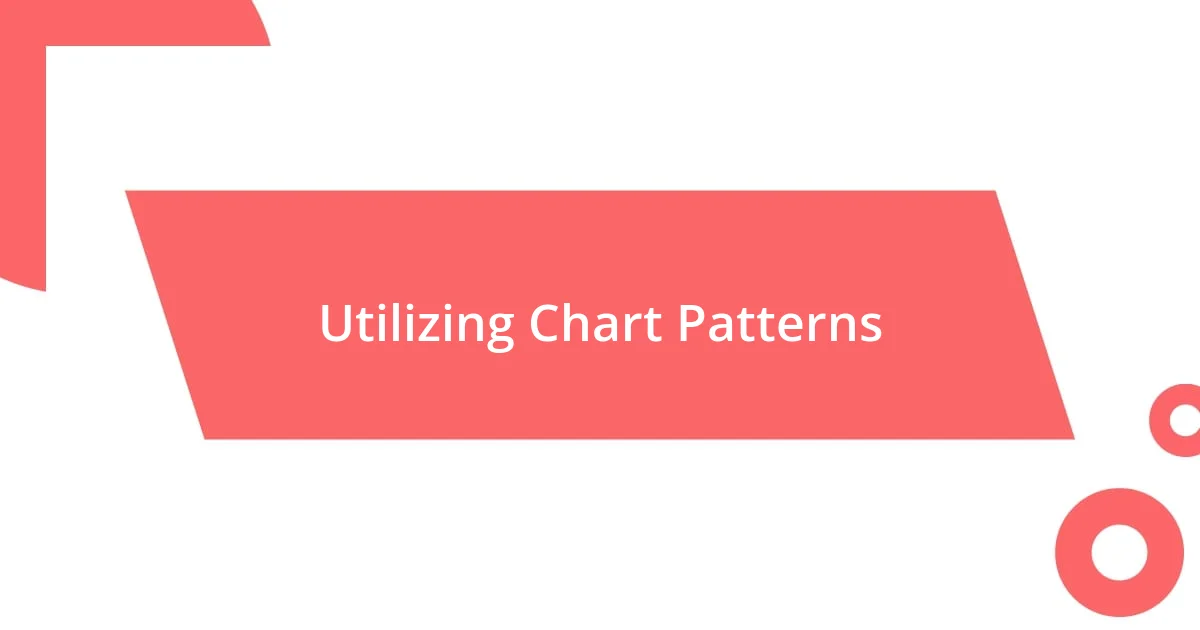
Utilizing Chart Patterns
Utilizing chart patterns in my analyses has been a transformative experience. There’s something fascinating about how certain shapes consistently indicate potential market movements. For instance, I remember the first time I identified a “head and shoulders” pattern; it felt like I had cracked a secret code. This pattern warned of a possible trend reversal, and I could feel my excitement as I adjusted my strategy accordingly.
One of the most powerful tools in my toolkit is the recognition of support and resistance levels. I’ve often found myself in scenarios where a stock repeatedly bounced off a specific price point. Observing this in action was eye-opening. Realizing that traders collectively react at these points made me appreciate the psychology of the market. Have you ever felt the thrill of riding a wave created by these levels? It’s exhilarating to see your decisions align with the broader trader behavior.
Diving deeper into patterns such as flags and pennants has also been rewarding. These formations often signify a continuation of trends, and I recall feeling a surge of confidence when I spotted a bullish flag that led to a profitable trade. It was a moment that reinforced my belief in using technical analysis — a reminder that the patterns on the chart are not just lines, but reflections of collective human behavior and market sentiment. Embracing these patterns has enhanced my insight into potential future price movements tremendously.

Employing Technical Analysis Tools
Employing technical analysis tools in my stock trend exploration has often felt like deciphering a visual language. The first time I stumbled across candlestick patterns, it was a game changer for me. I still remember analyzing a long green candle followed by a small red one, feeling a rush of anticipation that a potential reversal was on the horizon. Isn’t it amazing how a simple set of formations can convey so much about trader sentiment? Being able to read these nuances has certainly shaped my approach to trading.
Another tool that I find invaluable is the Fibonacci retracement levels. They often guide me in identifying areas of potential support and resistance, and I was amazed when I first used them effectively. I once missed a great buying opportunity because I neglected these levels; however, after incorporating them into my analysis, I caught a stock bouncing off a golden retracement level. Seeing that play out made me realize how these tools can pinpoint critical areas even before they happen, and it’s exhilarating to align my strategy with market dynamics.
Equally fascinating to me are the divergence signals that emerge from indicators like the RSI and MACD. I recall a time when I noticed bearish divergence while trading a tech stock; the price was hitting new highs, but the RSI was showing weakness. This discrepancy sparked my curiosity and helped me steer clear of potential losses. Have you ever experienced a moment where conflicting signals prompted you to rethink your strategy? This awareness of divergence not only sharpens my analytical skills but also deepens my understanding of market psychology, emphasizing the importance of being ahead of the curve.

Monitoring Market News and Trends
Monitoring market news and trends is something I approach with keen interest. I vividly remember the first time I caught wind of a major geopolitical event that altered market dynamics. It was almost overwhelming — news outlets were buzzing, and I instinctively shifted my portfolio to safeguard my investments. That experience reinforced how essential it is to stay informed; sometimes, a single news item can send shockwaves through the entire market.
Following economic indicators has also become a vital part of my routine. I recall tracking interest rate announcements and feeling a rush as I anticipated their impact on certain sectors. When the Federal Reserve hinted at a rate cut, I felt an excitement bloom in me, knowing that sectors like real estate could benefit significantly. Understanding these macroeconomic factors not only motivates my investment decisions but also adds an edge to how I analyze trends. Do you actively follow economic indicators to inform your investment choices?
On a more granular level, I pay close attention to social media discussions and sentiment analysis. There was a moment when I stumbled upon a rising conversation around a tech stock that piqued my interest. Watching the enthusiasm grow across platforms made me re-evaluate my stance and eventually led to a profitable engagement. It’s fascinating how such discussions can give real-time insights into trader sentiment — it’s like having a pulse on the market that goes beyond just numbers. Have you ever tapped into social media insights to gauge market trends? It’s a blend of intuition and data that keeps my trading strategies vibrant.
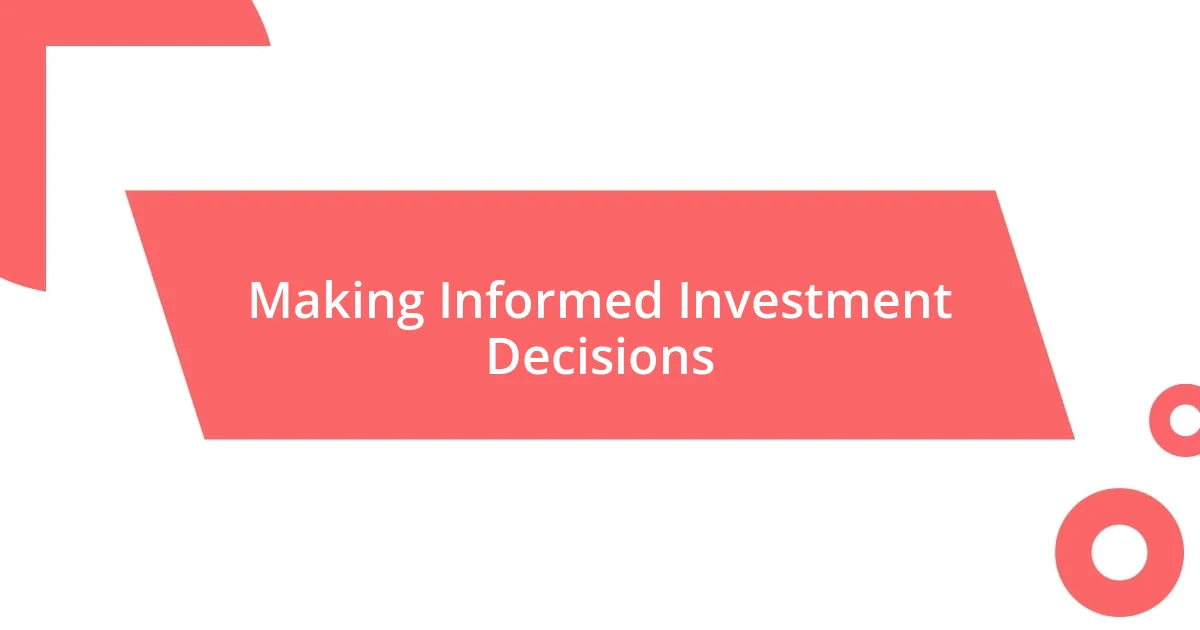
Making Informed Investment Decisions
Making informed investment decisions is a process I truly value. Once, I found myself in a unique situation when an earnings report for a company I followed was released unexpectedly early. The initial market reaction was panic, but I took a step back to analyze the details and realized the report had solid fundamentals despite the initial shock. That taught me the importance of not just reacting impulsively but delving deeper into the information at hand to guide my choices.
Another instance that stands out is when I decided to diversify my investments based on sector performance. I remember conducting an in-depth analysis of various industries and noticed that renewable energy stocks were gaining traction. Choosing to allocate a portion of my portfolio to this emerging sector not only felt like a smart decision—but it also aligned with my values. Have you ever experienced that satisfaction of knowing your investments reflect your personal beliefs? It feels good to put your money where your values are while also potentially reaping the rewards.
Lastly, I’ve come to appreciate the art of patience in investment. I once held on to a seemingly stagnant stock for several months, despite the noise urging me to sell. It was disheartening at times, but I believed in the company’s long-term potential. Finally, my persistence paid off when the stock surged, validating my approach. This experience reinforced that informed decisions often require a balance between analysis and emotional resilience. What about you? How do you manage your emotional responses when waiting for your investments to bear fruit?










